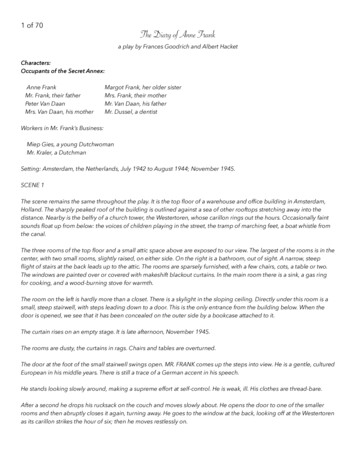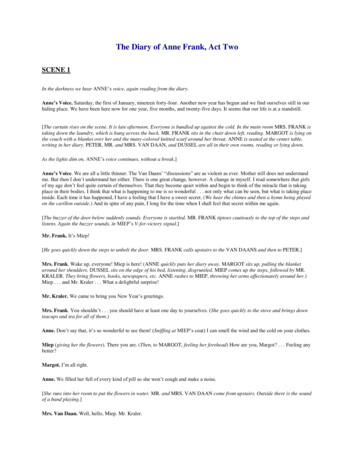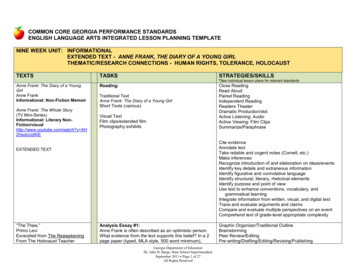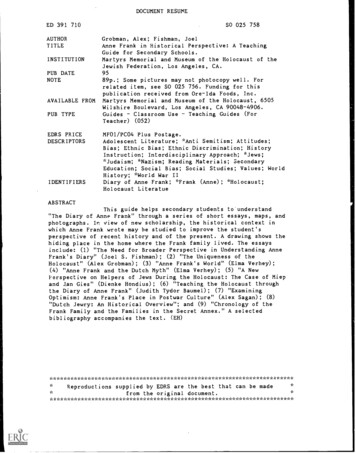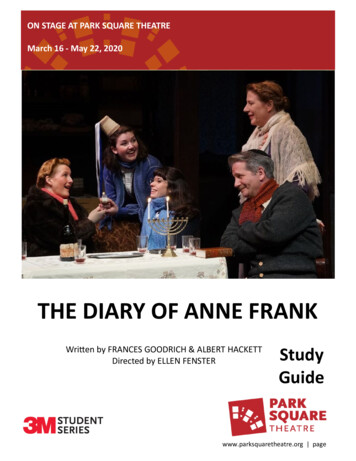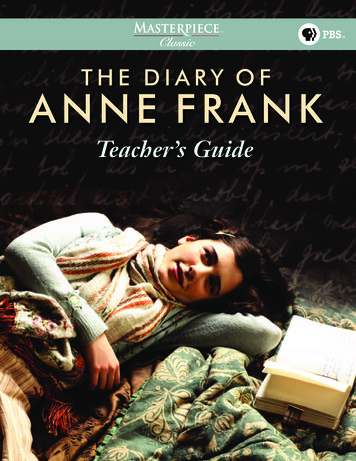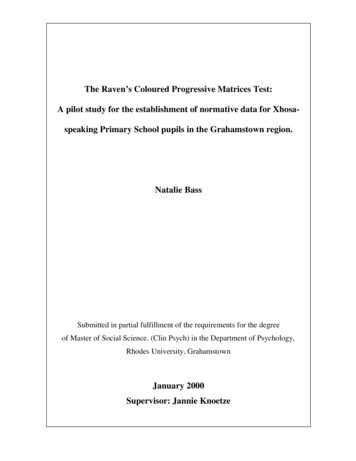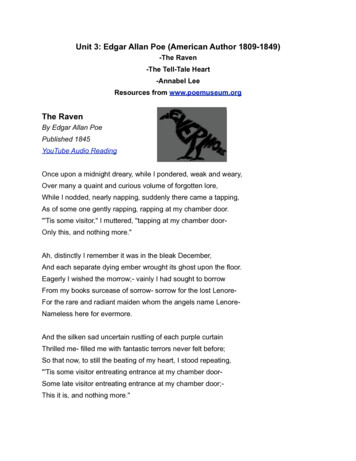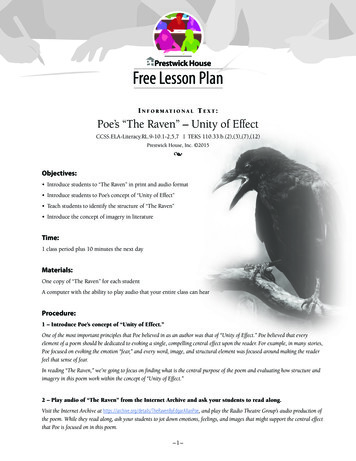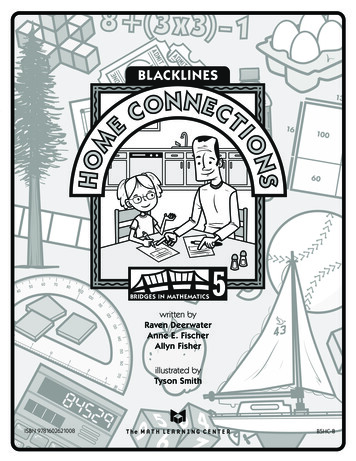
Transcription
written byRaven DeerwaterAnne E. FischerAllyn Fisherillustrated byTyson SmithISBN 9781602621008B5HC-B
Home Connections Blackline MastersBridges in Mathematics, Grade 5Bridges in Mathematics, Grade 5, package consists of—Getting StartedNumber Corner Teachers Guide, Volume OneBridges Teachers Guide, Volume OneNumber Corner Teachers Guide, Volume TwoBridges Teachers Guide, Volume TwoNumber Corner Blackline MastersBridges Teachers Guide, Volume ThreeNumber Corner OverheadsBridges Teachers Guide, Volume FourNumber Corner Student Book BlacklinesBridges Blackline MastersNumber Corner Calendar MarkersBridges OverheadsBridges Student Book BlacklinesHome Connections BlacklinesWork Place Student Book BlacklinesStudent Math Journal BlacklinesWord Resource CardsManipulativesNumber Corner ManipulativesThe Math Learning Center, PO Box 12929, Salem, Oregon 97309. Tel. 1 800 575–8130. 2007 by The Math Learning CenterAll rights reserved.Prepared for publication on Macintosh Desktop Publishing system.Printed in the United States of America.QP663 B5HC–BP0909The Math Learning Center grants permission to classroom teachers to reproduce blacklinemasters in appropriate quantities for their classroom use.Bridges in Mathematics is a standards-based K–5 curriculum that provides a unique blendof concept development and skills practice in the context of problem solving. It incorporates the Number Corner, a collection of daily skill-building activities for students.The Math Learning Center is a nonprofit organization serving the education community.Our mission is to inspire and enable individuals to discover and develop their mathematicalconfidence and ability. We offer innovative and standards-based professional development,curriculum, materials, and resources to support learning and teaching. To find out more,visit us at www.mathlearningcenter.org.This project was supported, in part, by the National Science Foundation. Opinionsexpressed are those of the authors and not necessarily those of the Foundation.ISBN 9781602621008
Student BooksThe blacklines in this packet are alsoavailable as a pre-printed student book.B5HC-1Home Connection BooksSingle Copy. B5HCPack of 10.B5HC10For pricing or to order please call 1 800 575–8130.
Unit One: Connecting Mathematical TopicsHome Connection 1: Worksheet, Math InterviewsHome Connection 2: Worksheet, More about Today’s Cube SequenceHome Connection 3: Worksheet, Exploring a New SequenceHome Connection 4: Worksheet, Story ProblemsHome Connection 5: Worksheet, Primes & CompositesHome Connection 6: Worksheet, Using Arithmetic PropertiesHome Connection 7: Worksheet, Taking OrdersHome Connection 8: Worksheet, Tile SequencesHome Connection 9: Worksheet, Range, Mode, Median & Mean (Average)Home Connection 10: Worksheet, Home Averaging1357111315192327Unit Two: Seeing & Understanding Multi-DigitMultiplication & DivisionHome Connection 11: Worksheet, Estimating Length in Metric UnitsHome Connection 12: Activity, Instructions for Multiplication Four in a RowMultiplication Four in a Row Record SheetHome Connection 12: Worksheet, Multiplication Four in a RowHome Connection 13: Worksheet, Multiplication SketchesHome Connection 14: Worksheet, Coins & Quick SketchesHome Connection 15: Worksheet, Looking for Metric Measures at HomeHome Connection 16: Worksheet, Multiplication InterviewHome Connection 17: Activity, Multiplication StrategiesHome Connection 18: Worksheet, Agree or Disagree?Home Connection 19: Activity, Instructions for Quotients WinGame SpinnersQuotients Win Game Sheet 1Quotients Win Game Sheet 2Go for Zero Record SheetHome Connection 20: Worksheet, Area & PerimeterHome Connection 21: Worksheet, Unit Review2935373841454953555963656768697177Unit Three: Geometry & MeasurementHome Connection 22: Worksheet, Shape PuzzlesHome Connection 23: Worksheet, Areas of Geoboard Figures8183
Home Connection 24: Worksheet, Thinking about QuadrilateralsHome Connection 25: Worksheet, Find the Angle MeasureHome Connection 26: Worksheet, Protractor Practice & Clock AnglesHome Connection 27: Worksheet, Reflections, Symmetry & CongruenceHome Connection 28: Activity, Area Bingo PracticeArea Bingo Cards: page 1 of 3Area Bingo Cards: page 2 of 3Area Bingo Cards: page 3 of 3Home Connection 29: Worksheet, Drawing Similar FiguresHome Connection 30: Activity, Net Picks3-Dimensional Figure Nets: page 1 of 23-Dimensional Figure Nets: page 2 of 2Home Connection 31: Worksheet, Volume & Surface Area87919397100103105107110113115117119Unit Four: Multiplication, Division & FractionsHome Connection 32: Activity, Estimation InterviewsHome Connection 33: Worksheet, More Multiplication MenusHome Connection 34: Worksheet, Multiplication & Division PracticeDivisibility RiddlesHome Connection 35: Worksheet, The Tangerine ProblemHome Connection 36: Worksheet, Lady LibertyHome Connection 37: Worksheet, Fraction & Division Story ProblemsHome Connection 38: Worksheet, The Mini-Quilt ProjectHome Connection 39: Worksheet, Egg Carton Fractions & MoreHome Connection 40: Worksheet, More Fraction Story ProblemsHome Connection 41: Worksheet, Unit Four Review121123125129131133135137141145147Unit Five: Probability & Data AnalysisHome Connection 42: Worksheet, Bar & Circle GraphsHome Connection 43: Worksheet, Presidents’ NamesHome Connection 44: Worksheet, Briana’s RoutesHome Connection 45: Worksheet, Another Spinner ExperimentHome Connection 46: Worksheet, Spinner & Dice ProbabilitiesHome Connection 47: Worksheet, Tallies & GraphsHome Connection 48: Worksheet, Reading Survey Data151155159163167169173Unit Six: Fractions, Decimals & PercentsHome Connection 49: Worksheet, Interpreting RemaindersHome Connection 50: Worksheet, Equivalent Fractions on a ClockHome Connection 50: Activity, Equivalent Fraction ConcentrationHome Connection 51: Activity, The Smaller the Better Fraction GameThe Smaller the Better Fraction Game 1The Smaller the Better Fraction Game 2Home Connection 52: Worksheet, Cafeteria Problems177181183185186187191
Home Connection 53: Worksheet, Modeling, Reading & Comparing DecimalsHome Connection 54: Worksheet, More Decimal WorkHome Connection 55: Worksheet, Decimal Sense & NonsenseHome Connection 56: Worksheet, Working with Decimals & PercentsHome Connection 56: Activity, Adding Decimals GameHome Connection 57: Worksheet, Finding PercentsHome Connection 58: Worksheet, Unit Six Review195197201203205207211Unit Seven: Algebraic ThinkingHome Connection 59: Activity, Instructions for The Operations GameThe Operations Game Cards: page 1 of 3The Operations Game Cards: page 2 of 3The Operations Game Cards: page 3 of 3Home Connection 60: Worksheet, Operations, Equations & PuzzlesHome Connection 61: Worksheet, More Tile PatternsHome Connection 62: Worksheet, Thinking About The King’s ChessboardHome Connection 63: Worksheet, The Function Machine Strikes Again!Home Connection 63: Activity, Instructions for The Function Machine GameWhat’s My Rule? Record Sheet 1What’s My Rule? Record Sheet 2Home Connection 64: Worksheet, The Lemonade StandHome Connection 65: Worksheet, Picturing t Eight: Data, Measurement, Geometry & Physics withSpinning TopsHome Connection 66: Activity, Circle SurroundHome Connection 67: Worksheet, Circle MathHome Connection 68: Activity, Circle ExplorationsHome Connection 69: Worksheet, Unit Eight Review247251256260
Home Connections For use after Unit One, Session 2.NAMEDATEHome Connection 1 H WorksheetMath InterviewsSelect a parent or other adult and ask them the following questions. Record theiranswers below.Name of the person interviewed1What is mathematics?2How do you use mathematics at home or at work?3What are your best mathematical abilities?4What are your strongest memories about learning math in school? The Math Learning CenterBridges in Mathematics 1
Home Connections2 Bridges in Mathematics The Math Learning Center
Home Connections For use after Unit One, Session 5.NAMEDATEHome Connection 2 H WorksheetMore about Today’s Cube Sequence1Here are the first 3 arrangements in the cube sequence we discussed in class.Explain what the pattern is to an adult at home and have the adult initial thesheet to show he or she understands.Arrangement 1Arrangement 22aHere is the fourth arrangement inthe sequence. How many cubes are inthis arrangement?Arrangement 3InitialsbShanda says you don’t have to countthe cubes one by one to find out howmany are in the 4th arrangement. Shesays there is 1 cube in the middle andthen 5 arms of 3 cubes each.Write an equation to show how Shandafigured out the number of cubes in the4th arrangement.3Arrangement 433331 cubeArrangement 4(Continued on back.) The Math Learning CenterBridges in Mathematics 3
Home ConnectionsHome Connection 2 Worksheet (cont.)3How many cubes are in the 5th arrangement? Use Shanda’s method or comeup with one of your own to figure it out without counting one by one. Label thepicture of arrangement 5 and write an equation to show your thinking.Arrangement 54How many cubes would it take to build the 23rd arrangement in this sequence?Show your thinking using numbers, words, and/or labeled sketches.CHALLENGE5A certain arrangement in this sequence takes 631 cubes to build. Which arrangement is it? Show your thinking using numbers, words, and/or labeledsketches.4 Bridges in Mathematics The Math Learning Center
Home Connections For use after Unit One, Session 6.NAMEDATEHome Connection 3 H WorksheetExploring a New SequenceArrangement 1Arrangement 2Arrangement 31What do you notice about the first three arrangements in the sequence above?2Sketch the 4th and 5th arrangements in this sequence.3How many cubes would it take to build the 149th arrangement? Explain youranswer using words, numbers, and/or a labeled sketch.4A certain arrangement takes 124 cubes to build. Which arrangement is it? Explain your answer using words, numbers, and/or a labeled sketch.(Continued on back.) The Math Learning CenterBridges in Mathematics 5
Home ConnectionsHome Connection 3 Worksheet (cont.)CHALLENGE5There are 8 people on a committee. Each time they meet, they shake handswith each other so that each person shakes everyone else’s hand once.aEach time they meet, how many handshakes are there?bImagine that 3 committee members arrive late. The other 5 members have already shaken hands. How many handshakes will there be when the 3 late members arrive?6 Bridges in Mathematics The Math Learning Center
Home Connections For use after Unit One, Session 8.NAMEDATEHome Connection 4 H WorksheetStory ProblemsSolve the problems below and on the next page. Show your work using words,numbers, and/or labeled sketches. Be sure to write your answer in the spaceprovided.1Over the summer, Kiyoshi’s neighbor paid him 7 each weekto water the flowers in her front yard. By the end of the summer, Kiyoshi earned 56. How many weeks did he water hisneighbor’s flowers?Kiyoshi watered the flowers for weeks.2Carlotta has 7 cousins. They are coming to her house fora party. She wants to get each cousin a bracelet that costs 6.How much money will Carlota need to buy a bracelet for all ofher cousins?Carlotta will need .3Terrell is helping his dad plant a vegetable garden. He isplanting seeds in rows. If Terrell plants 8 rows with 6 seeds ineach row, how many seeds will he plant in all?Terrell will plant seeds.(Continued on back.) The Math Learning CenterBridges in Mathematics 7
Home ConnectionsHome Connection 4 Worksheet (cont.)4Thirty-eight fifth graders at Vernon Elementary are going ona field trip to the zoo. They are riding in vans that each hold 9students. How many vans will they need for everyone to get tothe zoo?They will need vans.5Whitney and Troy baked 38 cookies for the bake sale. Theyput them in bags of 8 cookies each to sell at the bake sale.When they were done, they had some cookies left over. If theyshared the leftover cookies equally, how many cookies did eachperson get?Each person got cookies.(Continued on next page.)8 Bridges in Mathematics The Math Learning Center
Home ConnectionsHome Connection 4 Worksheet (cont.)6Brandon and Bethany baked 55 cookies for the bakesale. They put 8 cookies in each bag to sell. When theywere done, they had some left over. If they shared the leftoversequally, how many cookies did each person get?Each person got cookies.7Emma and Maggie made brownies for the bake sale.They made 52 altogether and put 4 in each bag. Theycharged 0.75 per bag and sold 7 bags.aHow much money did they make?bHow many bags of cookies did they have left?(Continued on back.) The Math Learning CenterBridges in Mathematics 9
Home ConnectionsHome Connection 4 Worksheet (cont.)8When Alex and Marcus went to the store with their mom,she said they could split the change evenly. The total costof their groceries was 57.32. She gave the cashier three 20 bills.aHow much money did Alex and Marcus get each?bWhat coins would they have needed to get in order to splitthe money evenly?9On Friday afternoon, Keira realizes she has put off herreading for too long and that she needs to finish her bookby Monday. The book is 265 pages long. She is on page 27. Howmany will she need to read each night to finish the book beforeschool on Monday morning?10 Bridges in Mathematics The Math Learning Center
Home Connections For use after Unit One, Session 10.NAMEDATEHome Connection 5 H WorksheetPrimes & CompositesWords in italics are defined at the top of the next page.1Make a quick sketch of all the rectangles that can be formed with tile for thenumbers 23, 32, 35, and 37.a23b32c35d372List all the factors for 23, 32, 35, and 37.a23b32c35d373aWhich of the numbers 23, 32, 35, and 37 are prime? Which are composite?are primebare compositeExplain how you made your choices.(Continued on back.) The Math Learning CenterBridges in Mathematics 11
Home ConnectionsHome Connection 5 Worksheet (cont.)When you multiply two whole numbers to get another number, the two numbers you multiplied are factors of the other number. Example: 3 and 5 are factorsof 15 because 3 5 15.A prime number only has two factors: 1 and itself. Example: 17 1 17A composite number has more than two factors. Example: 6 1 6 and 6 2 3.Note The number 1 is neither prime nor composite because it has just onefactor: itself.CHALLENGE4On the grid to the right, follow thedirections to color in all the compositenumbers.aColor in all the even numbers except 2 itself.bColor in all the numbers that end in5 except 5 itself.cColor in any numbers you get whenyou count by 3 except 3 itself. If youland on a number that is alreadycolored, you don’t have to color it intwice.dColor in any numbers you get whenyou count by 7 except 7 itself. If youland on a number that is alreadycolored, you don’t have to color it intwice.12 Bridges in 84858687888989 1019 2029 3039 4049 5059 6069 7079 8089 9099 100eList at least three mathematicalobservations about the numbers thatnever got colored in. The Math Learning Center
Home Connections For use after Unit One, Session 13.NAMEDATEHome Connection 6 H WorksheetUsing Arithmetic Properties1Do not use a calculator for these two problems. Multiply the numbers from leftto right.a23 5 7 2 b5 2 3 7 In which order was the multiplication above easier? Why?3aHere are three different ways to add the numbers 97, 48, 3, and 2. Circle theway that seems easiest and explain why it seems easiest to you.97 48 3 2b48 3 97 297 3 48 2Now add the four numbers and record the answer.(Continued on back.) The Math Learning CenterBridges in Mathematics 13
Home ConnectionsHome Connection 6 Worksheet (cont.)4Alonya had 48 stamps in her stampcollection. Then she got 12 more stamps.Which of the following shows a way tofind how many stamps Alonya has now? Divide 48 by 12.Subtract 12 from 48.Multiply 48 by 12.Add 12 to 48.5Corrina was planting seeds to growgreen beans. She had 36 seeds altogether.She planted 12 on Saturday and decided to plant the rest on Sunday. Whichexpression could you use to find outhow many seeds she had left to planton Sunday? 36 1236 – 1236 1236 12CHALLENGE7Ramona was having a birthday party. She got candy to put in her guests’party favor bags. She had 72 pieces ofcandy altogether. Before she could putthe candy in the bags, each of her 3brothers took 4 pieces. Then she divided what was left among the ten partyfavor bags. Write a single math expression to show how you could figure outhow many pieces of candy went ineach bag.8Write a story problem to match thefollowing expression.(56 7) (42 7)6Domingo baked 60 cookies for thebake sale. He ate 2 cookies and gavehis sister 2 cookies. Then he put thecookies in bags of 7 to sell at the bakesale. Which expression below wouldyou use to find out how many bags ofcookies Domingo filled? 14(60 – (2 2)) – 7(60 – (2 2)) 7(60 2 2) 7(60 7) – (2 2) Bridges in Mathematics The Math Learning Center
Home Connections For use after Unit One, Session 15.NAMEDATEHome Connection 7 H WorksheetNOTE TO FAMILIESWe have been working on order of operations in class. The order of operations is a set of rules tellingus what to do first when a problem has more than one operation. (Addition, subtraction, multiplication,and division are all operations.) These are the rules: Do anything inside parentheses first. Then do the multiplication or division from left to right. Then do the addition or subtraction from left to right.Here is how the order of operations works for this problem: (8 3) 3 – 11. First add 8 3 inside the parentheses: (8 3) 3 – 1 11 3 – 12. Then multiply 11 3 because multiplication goes before subtraction: 11 3 – 1 33 – 13. Now subtract: 33 – 1 32If you want to see why the order of operations is important, try doing the operations in another order.We need the order of operations so that we always arrive at the same answer.Taking Orders1You can put parentheses in a problem to show what to do first. See how manydifferent answers you can find for 12 2 4 – 1 by putting the parentheses indifferent places. Each time, write 12 2 4 – 1 with parentheses to show howyou got the answer.example(12 2) (4 – 1) 42I found different answers for 12 2 4 – 1.(Continued on back.) The Math Learning CenterBridges in Mathematics 15
Home ConnectionsHome Connection 7 Worksheet (cont.)2Below are three different answers for 8 3 6 2. Add parentheses to makeeach equation true.ab8 3 6 2 33c8 3 6 2 138 3 6 2 173aAsk up to four family members or friends to find the answer to each of theseproblems:12 2 4 – 18 3 6 2b Record their answers in the table below.c Write the correct answers using the order of operations at the bottom of the table.Name of Person12 2 4 – 18 3 6 2Using Correct Order of Operations4Use what you know about the order of operations to evaluate (find the answersto) the expressions below.a(7 8 2 2) (2 5)b37 12 4 – 1516 c(32 48 6 2) 12 17d(25 (5 49 (3 4)) – 5) 4(Continued on next page.)Bridges in Mathematics The Math Learning Center
Home ConnectionsHome Connection 7 Worksheet (cont.)CHALLENGE5Write your own expression. Use at least one set of parentheses to ensure anoperation is done earlier than it would be otherwise. Also make sure that youranswer turns out to be a whole number. The Math Learning CenterBridges in Mathematics 17
Home Connections18 Bridges in Mathematics The Math Learning Center
Home Connections For use after Unit One, Session 17.NAMEDATEHome Connection 8 H WorksheetTile SequencesArrangement 1Arrangement 2Arrangement 31What do you notice about the first three arrangements in the tile sequence above?2Sketch the 4th and 5th arrangements in this sequence.3How many tile would be in the 10th arrangement in this sequence? Use numbers, words, or labeled sketches to explain how you got your answer.It would take tile to build the 10th arrangement in the sequence.4What do you have to do to figure out how many tile are in any arrangement(or the nth arrangement) in this sequence? You can write an expression using nor explain your thinking in words. Draw a labeled sketch that shows how you arrived at your answer.(Continued on back.) The Math Learning CenterBridges in Mathematics 19
Home ConnectionsHome Connection 8 Worksheet (cont.)Arrangement 1Arrangement 2Arrangement 3Note The white squares in the middle of each arrangement do not count as tile.5What do you notice about the first three arrangements in the tile sequenceabove?6How many tile would be in the 10th arrangement in this sequence? Use numbers, words, or labeled sketches to explain how you got your answer.It would take tile to build the 10th arrangement in the sequence.7A certain arrangement in this pattern has 52 tile. Which arrangement is it?Use numbers, words, or labeled sketches to explain how you got your answer.(Continued on next page.)20 Bridges in Mathematics The Math Learning Center
Home ConnectionsNAMEDATEHome Connection 8 Worksheet (cont.)8What do you have to do to figure out how many tile are in any arrangement(or the nth arrangement) in the sequence on the previous page? You can write anexpression using n or explain your thinking in words. Draw a labeled sketch thatshows how you arrived at your answer.9Evaluate the following expressions using what you know about order of operations. Do the operations in this order: Do anything inside parentheses first, using the order shown below. Then do multiplication or division from left to right. Then do addition or subtraction from left to righta(4 56 8 3) 5b(11 72 (2 6) – 8) (32 16 1)c(125 (45 9) 4 6) – 33(Continued on back.) The Math Learning CenterBridges in Mathematics 21
Home ConnectionsHome Connection 8 Worksheet (cont.)CHALLENGE10aUse each of these numbers exactly one time to write an expression equal to9. You may go through many steps to arrive at a solution, but use what you knowabout order of operations to write your answer as a single expression.6093272bFind at least one more way to do it with the same numbers. Again, write youranswer as just a single expression.22 Bridges in Mathematics The Math Learning Center
Home Connections For use after Unit One, Session 19.NAMEDATEHome Connection 9 H WorksheetRange, Mode, Median & Mean (Average)1Use the information below to help find the range, mode, median, and mean ofthe numbers 4, 4, 5, 8, and 9.aThe range is the difference betweenthe highest and lowest values in a setof numbers.bThe mode is the value that shows upthe most in a set of numbers.4445845899mode:range: 9 – 4 cThe median is the middle value in aset of numbers.dThe mean or the average is the valueyou get when you level off all the numbers in a set.mean (average):44589median:(Continued on back.) The Math Learning CenterBridges in Mathematics 23
Home ConnectionsHome Connection 9 Worksheet (cont.)2aDisplay the following set of numbers on the grid: 2, 2, 3, 9, 14.bWhat is the range of that set ofnumbers?ecfWhat is the mode of that set ofnumbers?What is the mean (average) of thatset of numbers?Explain how you figured out themean (average) of those numbers.dWhat is the median in that set ofnumbers?(Continued on next page.)24 Bridges in Mathematics The Math Learning Center
Home ConnectionsNAMEDATEHome Connection 9 Worksheet (cont.)3aDisplay the following set of numbers on the grid: 1, 2, 3, 5, 7, 7, 10.bWhat is the range of that set ofnumbers?ecfWhat is the mode of that set ofnumbers?What is the mean (average) of thatset of numbers?Explain how you figured out themean (average) of those numbers.dWhat is the median in that set ofnumbers?(Continued on back.) The Math Learning CenterBridges in Mathematics 25
Home ConnectionsHome Connection 9 Worksheet (cont.)CHALLENGE4Wesley scored 14 points on his first math test. He wants to score enough pointson his next math test to have an average of 21 points. How many points will heneed to score on his next math test to have an average of 21 points? Use numbers,words, and/or a labeled sketch to show your work. Don’t forget to include the answer!5aFive numbers have an average of 11. Three of those numbers are 5, 6, and 9.What could the other two numbers be?b26If the range of the set of numbers is 13, what must the other two numbers be? Bridges in Mathematics The Math Learning Center
Home Connections For use after Unit One, Session 20.NAMEDATEHome Connection 10 H WorksheetHome Averaging1Collect at least 5 numbers from objects at home to create a data set. Here aresome ideas: the heights of at least 5 different cans of food, the number of boxes offood on at least 5 different shelves, the number of pictures or posters in at least5 different rooms, the number of chairs in at least 5 different rooms, the numberof books on at least 5 different shelves, or the heights of at least 5 different tables.Make sure the numbers relate to each other in some way.2When you have collected the numbers for the data set, list them in order fromsmallest to greatest below.3Explain how you collected your numbers. What are they about?4aFind the range, mode, median, and mean of the numbers you collected.rangebmodecmediandmean(Continued on back.) The Math Learning CenterBridges in Mathematics 27
Home ConnectionsHome Connection 10 Worksheet (cont.)5Now make a display of the numbers in your set. You can display them on thegrid below or make your display on another sheet of paper and attach it to thisassignment.Words to RememberRange: the difference between the highest and lowestnumber in a data set4 6 7 8 8 11 14Mode: the number that appears most often in a set ofnumbers. In any data set, there may be one mode, morethan one mode, or no mode.4 6 7 8 11 11 13Median: the middle number when the numbers in a dataset are arranged from lowest to highest14 – 4 104 6 7 8 8 11 13Mean: the number you get when you level off or even out allthe numbers in a data set. The mean is also called the average.228 Bridges in Mathematics7786666 The Math Learning Center
Home Connections For use after Unit Two, Session 1.namedateHome Connection 11 H WorksheetEstimating Length in Metric Units1Here is a quote from the book we read in class today, Millions to Measure, byDavid Schwartz:“Many people believe that the United States will eventually join the rest of theworld and measure only in the metric system.”Do you think this is a good idea or not? Please explain your answer.2This chart shows some of the metric units people use to measure length. Usethe information to help with the problems on the next page.Metric ––––––––centimetercm10 millimetersYour little finger is about 1centimeter wide.decimeterdm10 centimetersA new crayon is about 1decimeter long.meterm100 centimetersThe distance from the floor toa doorknob is about a meter.kilometerkm1000 metersA dime is about 1 millimeterthick.3 times around a footballfield is about a kilometer.(Continued on back.) The Math Learning CenterBridges in Mathematics 29
Home ConnectionsHome Connection 11 Worksheet (cont.)2aFind 5 things at home that are more than a decimeter long. List them belowand estimate the length of each in decimeters.ItemApproximate Length in DecimetersbFind at least 4 things at home that are about 1 meter long, wide, or high. Listthem below.3In Millions to Measure, David Schwartz says that a flea is about 1 millimeter tall.1 centimeter 10 millimetersaclose-up of a fleaWhat else could you measure in millimeters? List at least 5 ideas below.(Continued on next page.)30 Bridges in Mathematics The Math Learning Center
Home ConnectionsNAMEDATEHome Connection 11 Worksheet (cont.)3bComplete this table of equivalent centimeter and millimeter measurements.1 cm2 cm3 cm10 mm4 cm10 cm30 cm50 mm100 cm 1,000 cm500 mm4Cut out the centimeter ruler on page 33. Use it to draw four different rectangles that each have a perimeter of 24 cm. Then find the area of each rectangle.You can use the back of this page if you need more room.Words to RememberPerimeter: the total distance arounda shape.Area: the total number of squre unitsit takes to cover a shape.3 cm2 cm3 cm2 cm3 cm The Math Learning CenterP 2 3 2 3 10 cm2 cm2 cmA 2 3 6 square cm3 cmBridges in Mathematics 31
Home ConnectionsHome Connection 11 Worksheet (cont.)CHALLENGE5Use the centimeter ruler to draw some more rectangles with a perimeter of 24.This time, make sure the sides of the rectangles are not whole numbers. 3 and 6are whole numbers. 3 12 and 6.25 are not whole numbers.(Continued on next page.)32 Bridges in Mathematics The Math Learning Center
Home ConnectionsHome Connection 11 Worksheet (cont.)Cut out this centimeter ruler and use it for problems 4 and 5 on pages 31 and 32.12 The Math Learning Center345678910centimeters1112131415Bridges in Mathematics 33
Home Connections34 Bridges in Mathematics The Math Learning Center
Home Connections For use after Unit Two, Session 3.NAMEDATEHome Connection 12 H ActivityNOTE TO FAMILIESWe are studying double-digit multiplication in class. One way to solve a problem like 24 37 is to thinkof it as 4 smaller multiplication problems: 20 30, 20 7, 4 30, and 4 7. When you break it downthis way, you can see that it helps to be able to multiply single and double-digit numbers by 10 andmultiples of 10, like 20, 30, and 40. Multiplication Four in a Row and the related worksheet will help students practice this skill.You’ll need a partner and 2 small markers, such
Home Connections Blackline Masters Bridges in Mathematics, Grade 5 Bridges in Mathematics, Grade 5, package consists of— etting Started G ridges Teachers Guide, Volume OneB ridges Teachers Guide, Volume TwoB ridges Teachers Guide, Volume ThreeB ridges Teachers Guide, Volume FourB ridges Blackline Master
